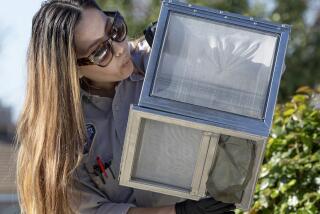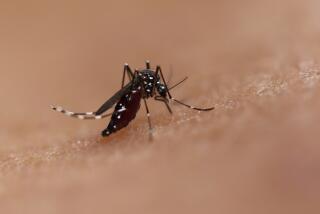Heads Up--It’s Lice Season, Students Warned
- Share via
As Ventura County students return to school next week, a creepy, age-old nuisance is sure to ride to class with them.
It’s lice season again, and the number of kids carrying the small translucent parasite is sure to increase as old friends put their itchy heads together after the summer break.
During the school year hundreds, or even thousands, of the county’s 130,000 public school students are likely to fight their own private--and sometimes humiliating--battle against the pest.
Indeed, many local school districts send afflicted students home, and won’t let them return until they are free of lice.
But killing this flat, 1/8-inch long, six-legged critter is not as simple as it used to be. There is mounting evidence that infestation is increasing throughout California, and that at least part of the reason is lice are developing an immunity to the toxic chemicals sold to kill them.
“We’re seeing our share of head lice. It’s up,” said Patricia Contini, school nurse for the Ventura Unified School District. “Unfortunately, the products aren’t as effective as they used to be, so you’re basically hand-picking them off.”
Lice are so resistant that county health nurses have stopped using Kwell, a high-potency antidote relied on for years, and switched to another insecticide-laced shampoo, said Marilyn Billimek, an epidemiologist with Ventura County Public Health Services.
Many parents are also finding that lower-strength drug store shampoos that once killed lice with an application or two must be augmented with other treatments, and with long hours of combing tiny eggs called nits out of their youngsters’ hair.
“It’s a chronic problem. It’s a nuisance. And it’s true about the shampoos not working as well,” said Christina Davis, co-chairwoman of the Ventura County School Nurses Organization. “I can see lice becoming a nuclear bug, so to speak.”
The process is complicated because the blood-sucking pests are clever, hiding on the backside of hairs and clinging tenaciously to strands even after the insects are dead.
And they flourish during the hot summer months.
So as school begins, nurses will inform parents that September is Pediculosis [lice infestation] Awareness Month. And school districts countywide will be pushing programs that tell students how to identify lice and instructing parents on how to combat the nuisance.
When a case is discovered in a class, parents are usually notified so they can check their children carefully. The insects are often found first behind the ears and at the nape of the neck.
A surprise to many is how often schools must deal with a lice problem. The National Pediculosis Assn. estimates there are 6 million to 12 million cases each year, reaching up to 5% of the country’s population.
Indeed, head lice infestation is the second-most common communicable childhood malady, ranking behind the common cold.
What that usually means on a personal level is student dismissal from school until all signs of lice and nits are gone. This no-nit policy common in local districts keeps some students with chronic cases out of class for many days each year.
“If we have 30 students in a class, three to five will have lice at any one time,” said Martha Romero, nurse for the Fillmore Unified School District.
Surprising too is that lice are equal opportunity pests--afflicting tony suburbs as well as inner city neighborhoods.
In most cases, experts say, lice are not the result of the host’s bad hygiene--though in chronic cases the problem often is that treatment has not been diligent.
“It’s not just a disease in Oxnard, it’s also a disease in Thousand Oaks and Simi Valley,” said pediatrician Chris Landon, who runs county-sponsored children’s clinics in both the east county and the west.
The number of lice cases is apparently up--though agencies do not keep a precise count--not only because medicines are not working as well as they once did, but because society has changed, Landon said.
“The largest problem, even in Thousand Oaks, is when you cram children into day care because you’ve got both parents working,” Landon said. “When you put children in close quarters, things spread rapidly.”
Landon’s own daughter, now nearly 16, was infested with lice twice when she was younger.
“My wife and daughter were working and my daughter was in day care with 15 children,” he said. “And it happened again in kindergarten. It’s not just a disease of the poor.”
Being poor, however, may make it harder to respond forcefully once lice are discovered.
In Fillmore, one of the county’s poorest communities, the cost of medicinal shampoo can delay a cure, nurse Romero said.
A single small bottle of shampoo costs about $10. So if four children are infected, and they all need at least two treatments, a low-income family may not be able to buy enough medicine. The school district provides a limited stock of sample shampoos to poor families, Romero said.
“The most important thing is removing the nits,” she said. “But that is expensive and very time-consuming. These days when mother and father both work, time is a factor just in combing out the nits.”
So what to do? Find the nits quickly before there are hundreds or thousands of eggs to deal with, then hit them hard, health experts say.
Regardless of economic circumstance, experts say the cure is the same: Treat with an over-the-counter shampoo, use special creams that allow nits to slip more easily from the hair. Comb the nits out or pick them out one by one if they persist.
Historically, parents of lice-ridden children have sometimes shaved their children’s heads. Officials, however, now recommend against such action because close-cropped hair on a girl may affect self-esteem. That, in turn, makes it more difficult to fully clear long hair of lice.
Just as important, school nurses say, is for all members of a family to check for lice and treat the infestation.
Floors and furniture should also be vacuumed, and bedding and clothing washed daily. But sometimes the infestation can linger for weeks or even months.
Then “we’ll send a public health nurse to talk about the nitty-gritty of how to get rid of lice. It’s not an easy job. They’re really tough to get rid of,” said public health’s Billimek.
(BEGIN TEXT OF INFOBOX / INFOGRAPHIC)
Head Lice: Facts and Treatment
Latin name: Pediculus humanus capitis
Size: 1/6 to 1/8 inch long
Legs: Six
How spread: Head-to-head contact
Myth: That they fly or jump
Food: Blood
Eggs: Female lays up to 10 per day
If someone in your home has head lice experts recommend these steps:
1. Try over-the-counter treatments such as Nix, Rid, Clear and A200. A physician or pharmacist should be consulted if the patient is pregnant or nursing, or has asthma or epilepsy.
2. Follow directions carefully and don’t overuse if lice persist.
3. Use a lice comb, baby safety scissors or fingernails to remove the lice eggs, known as nits. Nits are the size of sesame seeds; school health officials recommend using a strong light to help spot them.
4. Wash bedding and recently worn clothing in hot water and dry in a dryer. Combs and brushes should be soaked in hot water. Head lice feed on blood and cannot survive more than about 48 hours on soft surfaces such as bed linens.
Sources: National Pediculosis Assn. and health officials
More to Read
Sign up for Essential California
The most important California stories and recommendations in your inbox every morning.
You may occasionally receive promotional content from the Los Angeles Times.










